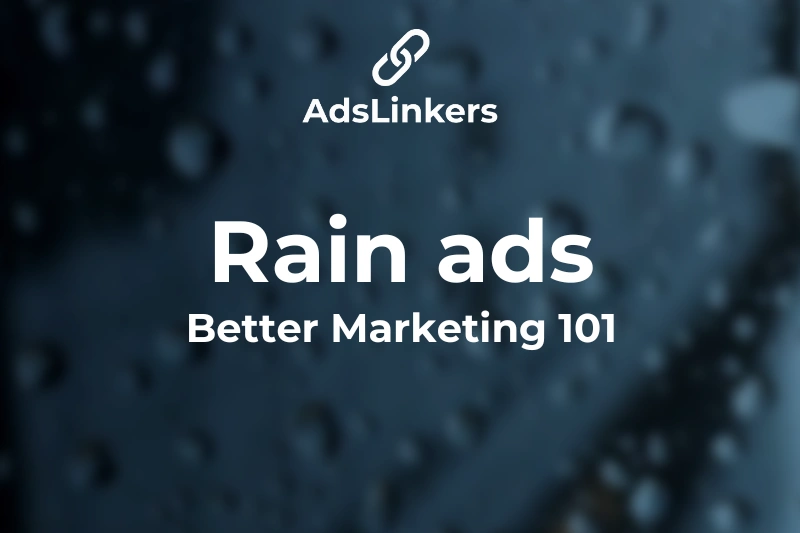September 21, 2024
by Bartosz Salamon
Share
In competitive digital advertising landscape, standing out requires not just creativity but smart, data-driven strategies. One highly effective but often underutilized tactic is rain ads—a form of weather-triggered advertising that adapts your marketing efforts based on real-time weather conditions. With platforms like AdsLinkers, implementing rain ads across TikTok, Meta, Google Ads, and programmatic networks such as DV360 and Adform becomes a streamlined process that can significantly boost engagement and ROI. Here’s a detailed guide on how to harness the power of rain ads to enhance your brand’s online visibility.

Source: Internal data from Programmatic campaign
What are rain ads and how do they work?
Rain ads use real-time weather data to automatically trigger specific advertisements when it starts to rain in a target location. This approach allows brands to deliver contextually relevant content, making their ads more timely and engaging. For example, a food delivery service might promote comfort food during a downpour, or a retailer could advertise raincoats and umbrellas precisely when the weather calls for it.
Using platforms like AdsLinkers, you can set up these weather-based triggers seamlessly. The technology involves integrating live weather data, allowing your campaigns to adjust dynamically based on predefined conditions like rain intensity, duration, or other relevant factors like wind or cloudiness. This real-time adaptability ensures that your marketing message hits at just the right moment.
Why rain ads are effective across multiple platforms?
TikTok’s short, visually immersive content format makes it a perfect playground for rain ads. When it’s raining, users are likely indoors, scrolling through TikTok for entertainment. This presents a prime opportunity for brands to deliver relevant content that matches the mood. For instance, an ad for a cozy drink or a binge-worthy show can feel especially enticing during a rainy day, driving higher engagement and interaction.

Meta: contextual relevance at scale
Rain ads on Meta platforms leverage the widespread reach of Facebook and Instagram, where users frequently browse their feeds, stories, and reels. By using rain triggers, brands can push ads that resonate with the current weather in specific geolocation, such as promoting indoor fitness classes or cozy apparel during a downpour. These platforms advanced targeting options also allow for hyper-localized campaigns, ensuring your ads are seen by the right audience in real-time.
Google Ads: Targeting search intents with precision
Google Ads enables brands to reach users based on their search behaviors. Rain ads can optimize this by showing specific search ads for items like “best rainy day activities” or “rainproof jackets” when the weather turns wet. On the display network, rain ads can visually capture the essence of rainy weather, appealing to users browsing content on millions of websites and apps.
Programmatic Advertising (DV360 and Adform): maximizing personalization
Programmatic platforms like DV360 and Adform offer the ability to scale rain ads across a vast network of digital properties with automated bidding and real-time adjustments. This makes them ideal for brands looking to maintain consistency and relevance across multiple channels. By leveraging programmatic’s advanced targeting and analytics, rain ads can be finely tuned to maximize performance, adapting not just to weather but also to audience behavior and content context. With AdLinkers tech you can automate Youtube insertion orders as well and improve your video campaigns.
Best practices for rain ads
- Choose the right products: not every product is suitable for rain ads. Focus on those that naturally align with rainy conditions, such as rain gear, indoor activities, or comfort food.
- Test and optimize: continuously test different creative approaches, target settings, and bid strategies. Use A/B testing to refine what resonates best with your audience during rainy weather.
- Leverage local insights: rain doesn’t fall uniformly everywhere. Utilize hyper-local targeting to ensure your ads are reaching users who are actually experiencing rain at that moment.
Use rain ads with AdLinkers!
Ready to start leveraging rain ads to boost your brand’s online presence? Contact AdsLinkers today to discover how our platform can help you implement weather-triggered advertising across TikTok, Meta, Google Ads, DV360, Adform, and more. Let’s make your marketing as dynamic as the weather!







